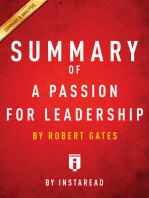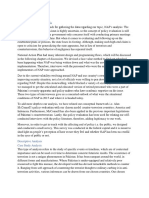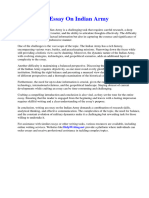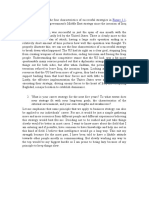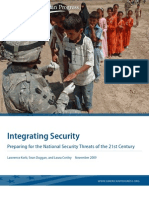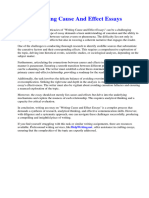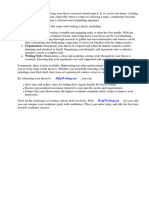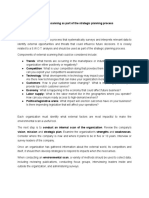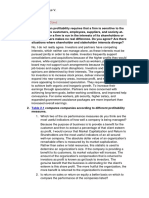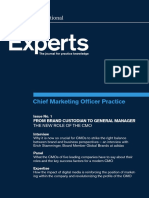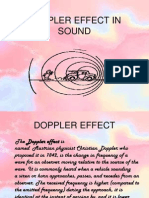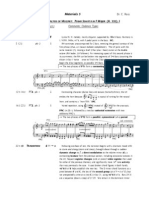Professional Documents
Culture Documents
Ass#1 Concept of Strategy
Ass#1 Concept of Strategy
Uploaded by
Gian Kaye Aglagadan0 ratings0% found this document useful (0 votes)
25 views6 pagesThe document discusses the US government's Middle East strategy since invading Iraq in 2003. It argues the strategy has consistently failed to achieve stable objectives or build a stable post-conflict Iraq. It also discusses Iraq's history of foreign influence over its oil resources and governments. The document then discusses career strategies and strategic planning processes for different types of companies.
Original Description:
Copyright
© © All Rights Reserved
Available Formats
PDF, TXT or read online from Scribd
Share this document
Did you find this document useful?
Is this content inappropriate?
Report this DocumentThe document discusses the US government's Middle East strategy since invading Iraq in 2003. It argues the strategy has consistently failed to achieve stable objectives or build a stable post-conflict Iraq. It also discusses Iraq's history of foreign influence over its oil resources and governments. The document then discusses career strategies and strategic planning processes for different types of companies.
Copyright:
© All Rights Reserved
Available Formats
Download as PDF, TXT or read online from Scribd
Download as pdf or txt
0 ratings0% found this document useful (0 votes)
25 views6 pagesAss#1 Concept of Strategy
Ass#1 Concept of Strategy
Uploaded by
Gian Kaye AglagadanThe document discusses the US government's Middle East strategy since invading Iraq in 2003. It argues the strategy has consistently failed to achieve stable objectives or build a stable post-conflict Iraq. It also discusses Iraq's history of foreign influence over its oil resources and governments. The document then discusses career strategies and strategic planning processes for different types of companies.
Copyright:
© All Rights Reserved
Available Formats
Download as PDF, TXT or read online from Scribd
Download as pdf or txt
You are on page 1of 6
Aglagadan, Gian Kaye V.
Assignment #1
2 – BSA-4
1. In relation to the four characteristics of successful strategies
in Figure 1.1, assess the US government's Middle East strategy
since the invasion of Iraq in 2003.
Focusing on the current crisis has resulted in consistent failures in the
US system's management of Iraq and the Middle East during the last
two decades, turning two unambiguous "victories" into certifiable losses.
From the overthrow of Saddam Hussein in 2003 to the present, the US
has never had a functioning excellent system for Iraq, nor any
foreseeable goals and actions that go beyond current events. The US
has never articulated useful national strategic objectives, made
compelling attempts to build a stable post-conflict Iraq, or demonstrated
to the Iraq populace that its presence truly serves their interests. At the
same time, the Pentagon announced that it spent more than $765 billion
on the Iraq war. as well as the fight against ISIS as of March 31, 2019 -
and this is only a small portion of the immediate cost. Despite the fact
that there is no clear stream of investigations into State or USAID
spending, it appears to have reached a new high of $100 billion.
Iraq, as one of the main producers of oil in the Middle East, put their
country's government support at jeopardy. Also, western nations,
particularly the United States, which are recognized for their brilliance
when it comes to advancing and controlling benefits over other
countries, chose to tamper with Iraq. In 1958, Iraq was governed by a
British-backed dictator, therefore the British decided to take advantage
of their oil resources. The center east faced an emergency as
Abdal-Karim Qasim, an Iraqi armed forces brigadier, ordered an
overthrow to maintain military power, which ousted the government.
They made do after that.
Iraq has transformed into a republic with a progressive gathering to
address the atrocities. They focused on women's liberties, better
education, and distributing wealth to the needy people. The western
abilities have froze as a result of the Iraqi republic's sudden
improvement. However, the country continued to move through with its
plans to nationalize oil transportation and standardize relations with
Russia. Furthermore, as a result of Qasim's unexpected decision during
his 5-year presidency, former President Kennedy gave the order to
stage an uprising, diverting attention away from Qasim's execution and
his organization's label as an anti-communist group. Sooner or later, the
Iranian dissatisfied saw how the western powers manipulated
everything to gain their acceptance, resulting in Iran's transformation
into an anti-western religious state. When the Iran-Iraq conflict broke
out, the western powers expressed support for both countries, but
clearly chose Iraq to provide them with weapons. Despite the fact that
Iraq makes the US organization acutely aware of major atrocities
committed with compound weapons and systems provided by the US,
they have remained silent. Fearing that the fight would spread across
Aglagadan, Gian Kaye V. Assignment #1
2 – BSA-4
the Middle East, the United States disguised an overwhelming strategy
against Iraq by refusing to stop them, despite their knowledge of Iraq's
plans to attack neighboring Middle Eastern countries. However, it did
not absorb the majority of the previous day's US decision to use their
advantage and restrain a powerful US international strategy, which
kicked off the US invasion on Iraq. Examining the system that the US
used in bombing Iraq and obtaining assets from Iraq, I may claim that it
was possibly ruthless, however they had an incredible technique.
However, it also demonstrated that if a party fails to grasp the four
characteristics of an effective procedure, their technique has a high
likelihood of failing. In truth, they only have one goal, which is to attack
Iraq and take advantage of its resources. However, just because you
have a single and extreme goal does not mean you are focused on it, as
I saw, read, and saw that the US was effectively lost from the start since
they routinely made short-term decisions. However, they succeeded in
passing the following phase by acclimating their abilities to the climate
by supporting Iraq and focusing on how the republic functioned, which
they also used as a development. Likewise, they also learned more
about their power's strengths and weaknesses, which is why they
offered compound weaponry and hardware (their solidarity) to gain
Iraq's trust. Finally, they consistently worked on their technique.
2. What is your career strategy for the next five years? To what
extent does your strategy fit with your long‐term goals, the
characteristics of the external environment, and your own
strengths and weaknesses?
For the past few years, I've been working on a list of potential careers
that I should pursue in the future. In any case, these vocations are
ordered in such a way that they are choices for each other rather than
decisions. Since secondary school, when I first began to open my eyes
to more practical open doors, I've learned one thing: "The only constant
in this world is change," and as a temperamental understanding, I've
realized that I am and will be prone to a plethora of vulnerabilities, and
that I will continue to resemble that until I figure out how to achieve the
fruitful profession/s I desire. I've been doing it since that day until now. I
don't have a reliable source of income. As the years pass,
circumstances change, which has a major impact on the methods that I
used, resulting in a constant change. As a result, I was able to draw
down a more versatile procedure. I made the decision to stick to a set of
rules and regulations. Other minor nuances were sacrificed due to the
constant changing of circumstances.
I aspire to be a capable bookkeeper, financial manager, and legal
advisor. Furthermore, regardless of the inconsistencies, these goals will
never change. I wanted to enroll in a state-funded college right away,
use my school store for minor expenses, and use the extra money to
start my own business and juggle managing it with thinking. However,
Aglagadan, Gian Kaye V. Assignment #1
2 – BSA-4
because to my weaknesses, I was unable to enlist in a state-funded
institution, implying that my school asset would not be overabundant. In
any event, I can't hope to make a difference with it, which is why I
decided to make tiny nuances and short-term targets flexible and
malleable solely for my long-term ambitions to be predictable. Normally,
my procedure has the ability to modify. Regardless, my long-term goals
have been and will continue to be consistent.
My solidarity is that I am an enthusiastic individual who will not be
deterred once my aims are set, which is in some ways my fault because
I frequently devote a great deal of effort and time to a few unimportant
tasks. In this way, I believe my system accommodates my long-term
goals, the outside environment, and my strengths and weaknesses
admirably and solidly. Since my procedure figured out how to make my
goals adjustable, adaptive, and predictable all at the same time.
I also add here what I have planned for my stategies over the next few
years:
1. Self-exploration is an opportunity to consider your talents,
interests, values, and whether or not you've integrated these into
previous work.
2. Researching firms, organizations, and functions of interest is
part of statistical surveying.
3. The center is the meeting place of the first two phases,
combining your interests with what's on the horizon and establishing a
goal for your entry-level job search.
4. Making your advertising materials to suit your unique brand is
referred to as arranging. The primary goal of the important arranging
process is to facilitate an arrangement, although the value of the activity
is frequently found in the process itself.
5. Execution is the stage of the mission where you go to job fairs,
organizational exercises, and job interviews, interviewing for jobs and
then effectively haggle for the best offer.
6. The term "vocation management" refers to the transition into a
new work, as well as periodic evaluations of your profession and the
flow back into the next phase of the employment cycle.
3. The discussion of the evolution of business strategy (see the
section “From Corporate Planning to Strategic Management”)
established that the characteristics of a firm's strategic plans and
its strategic planning process are strongly influenced by the
volatility and unpredictability of its external environment. On this
basis, what differences would you expect in the strategic plans
and strategic planning processes of Coca‐Cola Company and
Spotify SA, the Swedish‐based music streaming service?
Aglagadan, Gian Kaye V. Assignment #1
2 – BSA-4
We had the choice to dig deeper into the development from corporate
planning to strategic administration in the part "From Corporate
Planning to Strategic Management." This shift could be related to a rise
in market volatility and the business climate's eccentricity. Firms are
less likely to design technology in a precise manner as the external
environment becomes more chaotic. This will most likely result in
differences in how companies dealing with method making deal with
diverse industry conditions. Spotify SA should pay special attention to
societal patterns. They must also give evolving technology a lot of
thought, as a lot of the services they provide are centered on new and
working on portable innovation.
If we discuss the distinctions in the key strategies and organizing of
these two organizations, I assume there will be a lot because they have
different strengths and target markets. To begin with, Coca-Cola is a
conglomerate with various brands, but it is also a multinational
corporation.
Its main focus is on the refreshment industry, where it has found out
how to become the number one drink company. However, the
Coca-Cola Company, like any other beverage company, is subject to
Market immersion, which means that the amount of an item or service in
a commercial center has been increased. An organization might be
immersed in its environment. achieve additional development by
developing new products and stealing market share from competitors or
by an increase in client interest in general. The improvement of the
things will be the process they will use. They could also link
improvements or new things to current trends through bundling,
promotions, and other exciting activities that will urge the market to buy
in addition to the quality. Furthermore, Spotify SA will focus on their
target market. age and inclination. They will most likely commission a
research or other sort of data collection to learn more about the age
range of their supporters and compare it to the market's preferences.
For example, the age range is 13 to 20, and their current interest is
underappreciated music, therefore the company will focus on serving
the market's age and inclination.
4. I have noted that a firm's strategy can be described in terms of the
answers to two questions: “Where are we competing?” and “How
are we competing?” Applying these two questions, provide a
concise description of Lady Gaga's career strategy (see Strategy
Capsule 1.2).
Lady Gaga has shown a respectable commitment to the goal of
superstardom, which she has pursued with zeal since she was a child.
Different aspects of her life were either subordinated to or absorbed into
her professional goals. Rather than waiting for industry trends to
emerge, she has taken steps to influence her general environment. She
believes that she has had a burning desire to become a celebrity for
Aglagadan, Gian Kaye V. Assignment #1
2 – BSA-4
nearly as long as she can remember; to enthrall and inspire others to do
so. She was and continues to be open about her concept of fame:
"Some people are simply conceived stars. You either have it or you
don't, and I was certainly conceived one." In the same way that Lady
Gaga has created career plans and long-term goals to achieve success,
businesses should have a vision of where they want to go and how they
will go to get there.
There are five major focuses in her approach. The first is that she is
aware of her own image well. When you ask people to offer you an
unusual or unusual trademark, many of them will effectively give you the
name "Lady Gaga" because it is her image. Her clothing, music
recordings, and eve melodies and interviews all reflect the personality
of her image. She is so familiar with her image that she can readily tie
everything about herself to her well-known visual trademark. The
second reason is that she is well-versed in her industry. We all know her
image is about colors and weird people, and what gathering or
orientation has a creative mind like her that would profit from her
personality? The LGBTQIA+ community, which is well-known and
respected. As you can see, she used her personality openly for that
particular neighborhood, which ended up having the largest impact on
everything and everyone. Third, from her first collection, "The Fame," to
her most recent "Chromatica," you can see how the subtleties are linked
to the latest item, and if they aren't, she starts a trend or ensures that
every last detail of her collections is explored and shown, detail by detail.
Fourth, Lady Gaga has figured out how to be in the spotlight all of the
time. From the release of a new collection or from the red rugs and her
unusual design. She never permitted the media or her market ignore
her, even if it was only for a brief time. She re-invents strategies that
aren't working. Her fan base grew as a result of her appearances on
television. It might be from a meeting, an honorary pathway, design
news, a TV show, or even a movie.
5. Using the framework of Figure 1.6, describe the strategy of the
university or school you attend.
New Era University places God at the center of everything they do. It
has its own vision, mission, theory, goals, and objectives. Fill in as a
technique that enables you to oversee and compete with other
universities in the most efficient way possible. A world-class educational
institution with a unique Christian culture of excellence, discipline, and
administration to humanity.
6. Your business school is considering appointing as dean someone
whose entire career has been spent in business management.
What challenges might the new dean face in applying her strategic
management skills to a business school?
Senior employees of business institutions have a large and intricate role
in the fabric of the colleges and networks that their programs serve.
Aglagadan, Gian Kaye V. Assignment #1
2 – BSA-4
Many gleaming new dignitaries, on the other hand, discover that the
experiences they gain while climbing the ranks of academia or industry
do not fully prepare them for their new responsibilities. While some
deans have worked in office occupations where they dealt with a small
group of coworkers, being a dignitary requires them to manage a
greater range of challenges and activities. They accept responsibility for
a school's research portfolio rather than focusing on particular initiatives.
Rather of managing relationships with a small number of coworkers,
they take on the responsibility of establishing relationships with internal
staff and external partners, such as donors, graduates, the media, and
the business community. Furthermore, deans accept responsibility for
their school's funds and contribution to the larger college, and they
should advocate for their business college's interests among a college's
senior leadership, givers, and government partners in order to obtain
the necessary resources to support existing programs or develop new
ones. Similarly, without the assistance of others, corporate expertise
alone may not be sufficient to prepare a chief went dignitary to properly
pick employees or investigate changes in an academic culture.
Approaching business college dignitaries in this climate is extremely
difficult. Dignitaries are responsible for positioning their schools for the
future and ensuring that enough resources, such as money, staff,
students, and physical resources, are in place to meet that objective.
Today, schools are being put to the test in order to develop global
leaders, adjust to the digitization of instruction, and change educational
programs in order to strike a balance between greater specialization
and broader leadership qualities. As a result, many projects are
scrambling to fulfill the changing needs of the commercial centers
where their graduates are stationed. Furthermore, rising competition
among programs places a strategic essential on improving the value
and relevance of the instruction they provide to understudies.
You might also like
- Becoming A Conflict Competent LeaderDocument237 pagesBecoming A Conflict Competent Leaderartemis100% (2)
- USA IncDocument237 pagesUSA IncKSIRCapitalNo ratings yet
- Establishing Strength Training Program FootballDocument6 pagesEstablishing Strength Training Program Footballzaid786786No ratings yet
- Contemporary Strategy Analysis Ch1Document3 pagesContemporary Strategy Analysis Ch1Beta AccNo ratings yet
- Ass#1 Concept of StrategyDocument3 pagesAss#1 Concept of StrategyAldyn OlermoNo ratings yet
- Contemporary Strategy Analysis Text and Cases 9th Edition Grant Solutions ManualDocument25 pagesContemporary Strategy Analysis Text and Cases 9th Edition Grant Solutions ManualEarlCollinsmapcs100% (61)
- Full Download Contemporary Strategy Analysis Text and Cases 9th Edition Grant Solutions ManualDocument35 pagesFull Download Contemporary Strategy Analysis Text and Cases 9th Edition Grant Solutions Manualmirthafoucault100% (39)
- Dwnload Full Contemporary Strategy Analysis Text and Cases 9th Edition Grant Solutions Manual PDFDocument35 pagesDwnload Full Contemporary Strategy Analysis Text and Cases 9th Edition Grant Solutions Manual PDFwadamsmdva100% (17)
- RAND - Preparing For Great Power Conflict How Experience Shapes Military TrainingDocument209 pagesRAND - Preparing For Great Power Conflict How Experience Shapes Military Trainingindra alverdianNo ratings yet
- Public Policy Dissertation TitlesDocument4 pagesPublic Policy Dissertation TitlesAcademicPaperWritersCanada100% (1)
- Unfinished BusinessDocument143 pagesUnfinished BusinessLeandro Casini AciarNo ratings yet
- Summary of A Passion for Leadership: by Robert Gates | Includes AnalysisFrom EverandSummary of A Passion for Leadership: by Robert Gates | Includes AnalysisNo ratings yet
- Master Thesis Strategic ManagementDocument4 pagesMaster Thesis Strategic Managementesthernasusnewark100% (2)
- Volatile, Uncertain, Complex, and Ambiguous: Leadership Lessons From IraqDocument18 pagesVolatile, Uncertain, Complex, and Ambiguous: Leadership Lessons From IraqShahNo ratings yet
- BY Other Means: Part I: Campaigning in The Gray ZoneDocument51 pagesBY Other Means: Part I: Campaigning in The Gray Zoneb4398385No ratings yet
- Thesis Topics For High School SeniorsDocument7 pagesThesis Topics For High School Seniorsafbsbvoak100% (2)
- Chapter 5: Data Analysis: Descriptive Analysis Case Study AnalysisDocument3 pagesChapter 5: Data Analysis: Descriptive Analysis Case Study AnalysisAbdullah KhushnudNo ratings yet
- Essay On Indian ArmyDocument6 pagesEssay On Indian Armyaaqvuknbf100% (2)
- Learning The Right Lessons From Iraq, Cato Policy Analysis No. 610Document20 pagesLearning The Right Lessons From Iraq, Cato Policy Analysis No. 610Cato Institute100% (2)
- Full Download Test Bank For Essentials of Entrepreneurship and Small Business Management 9th by Scarborough PDF Full ChapterDocument36 pagesFull Download Test Bank For Essentials of Entrepreneurship and Small Business Management 9th by Scarborough PDF Full Chapterfencingvesper9dgb04100% (21)
- STRABA - Assignment 1Document4 pagesSTRABA - Assignment 1Biancajane KinatadkanNo ratings yet
- Bach Blake 2016 Frame or Get Framed The Critical Role of Issue Framing in Nonmarket ManagementDocument22 pagesBach Blake 2016 Frame or Get Framed The Critical Role of Issue Framing in Nonmarket Managementmccallk2003No ratings yet
- The Role of Government Policy in Fostering Entrepreneurship: A Usa and Africa ReviewDocument16 pagesThe Role of Government Policy in Fostering Entrepreneurship: A Usa and Africa ReviewTamer KarmNo ratings yet
- Master Thesis Due DiligenceDocument8 pagesMaster Thesis Due Diligencejennifermoserreno100% (2)
- How To Plagiarize An EssayDocument5 pagesHow To Plagiarize An Essayafhbdbsyx100% (2)
- Big Israel by Grant SmithDocument65 pagesBig Israel by Grant SmithDave ZenkerNo ratings yet
- The Two-Year Plan: How To Build Wealth And Achieve Financial Freedom: Wealth Building, #1From EverandThe Two-Year Plan: How To Build Wealth And Achieve Financial Freedom: Wealth Building, #1No ratings yet
- Marketing 2nd Edition Hunt Test BankDocument25 pagesMarketing 2nd Edition Hunt Test BankStacyCarrgpjkb100% (61)
- State Magazine, October 2005Document44 pagesState Magazine, October 2005State MagazineNo ratings yet
- Thesis Title For Economics UndergraduateDocument6 pagesThesis Title For Economics Undergraduatenadugnlkd100% (2)
- 11 Psychological and Economic Development Paper - 2Document18 pages11 Psychological and Economic Development Paper - 2Odaa BultumNo ratings yet
- Nonprofit Investment and Development Solutions: A Guide to Thriving in Today's EconomyFrom EverandNonprofit Investment and Development Solutions: A Guide to Thriving in Today's EconomyNo ratings yet
- Affirmative Action Research Paper OutlineDocument4 pagesAffirmative Action Research Paper Outlinewtdcxtbnd100% (1)
- Research Paper On Organizational PoliticsDocument8 pagesResearch Paper On Organizational Politicsvbbcvwplg100% (1)
- International Relations Dissertation ProposalDocument5 pagesInternational Relations Dissertation ProposalPaperWriterServicesCanada100% (1)
- 1 Interp: Aid Is Money in The Form of Gifts, Grants, or Loans. Kenton 3/20Document14 pages1 Interp: Aid Is Money in The Form of Gifts, Grants, or Loans. Kenton 3/20Jillian LilasNo ratings yet
- Integrating Security: Preparing For The National Security Threats of The 21st CenturyDocument65 pagesIntegrating Security: Preparing For The National Security Threats of The 21st CenturyLuis Dirceu Rodriguez VillalobosNo ratings yet
- Chapter IDocument9 pagesChapter IArthur John GarratonNo ratings yet
- CIA Research Paper TopicsDocument6 pagesCIA Research Paper Topicsuylijwznd100% (1)
- Corporate Governance Regulation: How Poor Management Is Destroying the Global EconomyFrom EverandCorporate Governance Regulation: How Poor Management Is Destroying the Global EconomyNo ratings yet
- My DocumentDocument6 pagesMy DocumentLeonardo OliveiraNo ratings yet
- Asef TMUDocument57 pagesAsef TMUMd. Saiful IslamNo ratings yet
- Social Studies Coursework Question 3Document4 pagesSocial Studies Coursework Question 3afjwduenevzdaa100% (2)
- Thesis Proposal International RelationsDocument7 pagesThesis Proposal International Relationsmak0dug0vuk2100% (2)
- Rand Rra1794-2Document117 pagesRand Rra1794-2Dorjee SengeNo ratings yet
- The Complete Personal Finance Handbook: Step-by-Step Instructions to Take Control of Your Financial FutureFrom EverandThe Complete Personal Finance Handbook: Step-by-Step Instructions to Take Control of Your Financial FutureNo ratings yet
- Making An EvaluationDocument11 pagesMaking An EvaluationYui HirasawaNo ratings yet
- Polsci Module3Document7 pagesPolsci Module3Janice Dano OnaNo ratings yet
- Osu Honors Thesis RequirementsDocument8 pagesOsu Honors Thesis Requirementsglennabeitelspachersiouxfalls100% (2)
- Strategic Risk Management: A Practical Guide to Portfolio Risk ManagementFrom EverandStrategic Risk Management: A Practical Guide to Portfolio Risk ManagementRating: 5 out of 5 stars5/5 (1)
- Plan Your Financial Future: A Comprehensive Guidebook to Growing Your Net WorthFrom EverandPlan Your Financial Future: A Comprehensive Guidebook to Growing Your Net WorthNo ratings yet
- Writing Cause and Effect EssaysDocument6 pagesWriting Cause and Effect Essaysgqdknjnbf100% (2)
- Building Militaries in Fragile States: Challenges for the United StatesFrom EverandBuilding Militaries in Fragile States: Challenges for the United StatesNo ratings yet
- Israel Thesis TopicsDocument6 pagesIsrael Thesis Topicsafkomeetd100% (2)
- Novdec 2022 PFDocument287 pagesNovdec 2022 PFaryatailor10No ratings yet
- Research Perry SSGDocument10 pagesResearch Perry SSGPerry AdamsNo ratings yet
- MGT 11 - Lesson 2Document6 pagesMGT 11 - Lesson 2Kaye Cuaresma RebucasNo ratings yet
- Research Paper NgoDocument5 pagesResearch Paper Ngokkxtkqund100% (1)
- Ass#2 Values, Goals, PerformanceDocument3 pagesAss#2 Values, Goals, PerformanceGian Kaye AglagadanNo ratings yet
- Ass#1 Concept of StrategyDocument6 pagesAss#1 Concept of StrategyGian Kaye AglagadanNo ratings yet
- Ass#2 Values, Goals, PerformanceDocument3 pagesAss#2 Values, Goals, PerformanceGian Kaye AglagadanNo ratings yet
- Chapter 2Document56 pagesChapter 2Gian Kaye AglagadanNo ratings yet
- Aglagadan, Gian Kaye v. - Assignment - FINAMARDocument8 pagesAglagadan, Gian Kaye v. - Assignment - FINAMARGian Kaye AglagadanNo ratings yet
- sjzl20060795-Unitrans+ZXONM+E300 (V3 (1) 17) +Operation+Manual PDFDocument190 pagessjzl20060795-Unitrans+ZXONM+E300 (V3 (1) 17) +Operation+Manual PDFVinh Hoàng Thành100% (1)
- Collimation Tool Instruction SheetDocument2 pagesCollimation Tool Instruction SheetmihaNo ratings yet
- Management Accounting Perspective: © Mcgraw-Hill EducationDocument12 pagesManagement Accounting Perspective: © Mcgraw-Hill Educationabeer alfalehNo ratings yet
- CDSCO Adds Another Port For Enhancing Import of DrugsDocument8 pagesCDSCO Adds Another Port For Enhancing Import of DrugsPrasenjit DasNo ratings yet
- Azure Mfa Enrollment ProcessDocument46 pagesAzure Mfa Enrollment Processkkumar_717405No ratings yet
- Molecular Biology, Pathogenesis and Pathology of MumpsDocument10 pagesMolecular Biology, Pathogenesis and Pathology of MumpsHarry SalomoNo ratings yet
- A Lifespan Perspective On Multi Professional Musicians Does Music Education Prepare Classical Musicians For Their CareersDocument15 pagesA Lifespan Perspective On Multi Professional Musicians Does Music Education Prepare Classical Musicians For Their CareersfedeNo ratings yet
- Origanum Majorana L. - Phyto-Pharmacological Review: January 2015Document8 pagesOriganum Majorana L. - Phyto-Pharmacological Review: January 2015VALERIA RODRIGUEZ CASPITONo ratings yet
- Mercedes-Benz Specified Engine Oils (Service) - OverviewDocument2 pagesMercedes-Benz Specified Engine Oils (Service) - OverviewRyan Mac Intosh100% (1)
- Lesson 4 Statement of The Problem PDFDocument18 pagesLesson 4 Statement of The Problem PDFSOPHIAJASMINE SICIONo ratings yet
- L G 0016125104 0051669710Document30 pagesL G 0016125104 0051669710Hospital Basis50% (2)
- Career Day Parent LetterDocument2 pagesCareer Day Parent Letterapi-233314088No ratings yet
- 3 Ideas Positive Run8 Background and MechanicsDocument9 pages3 Ideas Positive Run8 Background and MechanicsKatz EscañoNo ratings yet
- International Operations ManagementDocument14 pagesInternational Operations ManagementFaisal BhattiNo ratings yet
- Factors of Asian IntegrationDocument9 pagesFactors of Asian IntegrationVazima Qt100% (1)
- Purair Class Ii Type A2Document8 pagesPurair Class Ii Type A2Pedro978No ratings yet
- Final Rural Land Administration Level II CMDocument73 pagesFinal Rural Land Administration Level II CMwehabrebi awelNo ratings yet
- Cipelt Application Form Portugal Paulo TavaresDocument2 pagesCipelt Application Form Portugal Paulo TavaresPaulo Tavares100% (1)
- The New Role of The Cmo 1Document24 pagesThe New Role of The Cmo 1Alan SucariNo ratings yet
- Seamless Steel Tubes For The Construction Industry and Mechanical EngineeringDocument12 pagesSeamless Steel Tubes For The Construction Industry and Mechanical EngineeringJose Lorenzo ToralNo ratings yet
- (1989) 3 W.L.R. 1150Document43 pages(1989) 3 W.L.R. 1150pieremicheleNo ratings yet
- (EMPR) Catalog EN 202006Document132 pages(EMPR) Catalog EN 202006Ekanit ChuaykoedNo ratings yet
- 1b. Annex B - Poster SessionDocument2 pages1b. Annex B - Poster SessionMarchena Segil ErikNo ratings yet
- Sample Paper - 3 Class 9 Maths Term 2Document3 pagesSample Paper - 3 Class 9 Maths Term 2Palaniappan RamanathanNo ratings yet
- QSK38 Epa 4 - Imo IiiDocument2 pagesQSK38 Epa 4 - Imo Iiijorge luisNo ratings yet
- Doppler Effect & Its ApplicationsDocument32 pagesDoppler Effect & Its ApplicationsNandini SkNo ratings yet
- Mozart k.332Document4 pagesMozart k.332PalGnomeNo ratings yet
- Using SQL Developer: Oracle University and Cibertec Peru SฺAฺCฺ use onlyฺDocument36 pagesUsing SQL Developer: Oracle University and Cibertec Peru SฺAฺCฺ use onlyฺMarcos David Revoredo MezaNo ratings yet
- Scomi Oiltools DWMS OverviewDocument16 pagesScomi Oiltools DWMS Overviewmojtaba_m007No ratings yet











